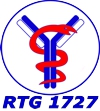associated TP33: The role of lymphocyte-derived factors in the effector phase of pemphigoid diseases
The effector phase of pemphigoid disorders (PD) is characterized by an increased infiltration of myeloid cells, especially PMNs, into the upper dermis which cause after recruitment and activation inflammation of the skin. This recruitment and activation of myeloid cells is regulated by a network of different lymphocyte populations, including γδ T cells, NKT cells, Tregs and IL-10+ plasma cells. These different populations indicate potential disease-promoting and disease-suppressing local roles of the different subsets of lymphocytes.
It is already known that γδ T and NKT cells positively affect the migration and activation of PMNs, and that Tregs and IL-10+ plasma cells counteract inflammation, mainly through the formation and release of IL-10.
It has now been shown in previous work that depletion of Tregs enhances passive PD in mice and upregulates the proinflammatory cytokine IFN-γ. In contrast, PMNs co-cultured with Tregs has shown a lower expression of CD18, a key molecule that facilitates PMN migration into inflamed skin. In vivo, the expansion of Tregs by administration of IL-2 / antibody complexes could reduce PMN infiltration and inhibited skin inflammation in a murine contact hypersensitivity model.
In summary, these results show new, promising therapeutic principles for PDs in respect to Tregs. However, the mechanisms of how Tregs serve a protective function in PDs are still largely unknown.
Therefore, our aim is to investigate the molecular mechanisms of Tregs to counteract the effector phase of PDs and to use these mechanisms for novel therapeutic strategies for the treatment of PDs. On this account, the cellular and molecular mechanisms of Treg suppression of skin inflammation in PDs and their spatiotemporal kinetics of migration and their physical interactions with other cell types in PD skin lesions, especially PMNs, Macrophages and keratinocytes in vitro and in vivo will be investigated. As well as the therapeutic potentials of administration of the IL-2 / anti-IL-2 mAb JES6-1 complex and of adoptive transfer of Tregs into PD will be studied.

- Projects
- Projects
- Associated projects
- associated TP 31 - C5a/C5aR1 axis in EBA
- associated TP 32 - Cryptic antinuclear autoantibodies
- associated TP 33 - Lymphocyte-derived factors in the effector phase...
- associated TP 34 - The Role of C5aR2 in the Pathogenesis of Pemphigoid Diseases
- associated TP 35 - The role of IgG glycosylation in the attenuation of anaphylactic reaction
- associated TP 36 - Effects of different vaccination strategies on the development of different glycosylated IgG antibodies
- MD projects
- Associated MD projects
- Concluded projects






